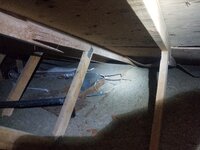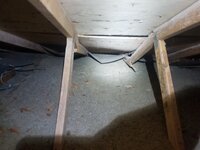master_baiter_fishing
Student
- Apr 1, 2025
- 1
Looking at a job for a homeowner in Washington State. A tree limb fell on his roof a few nights ago. Pictured below are the damaged members. The first two pictured I'm fairly confident I can splint with 2x4 or gusset (let me know if you disagree). The last picture, the member on the right, is broke in two places, the obvious closest to the eve and the other under the connector plate. The one beside it is cut entirely in one place. Chords are about 14ft long.
Should I recommend full replacement of the trusses in the last picture? Can a 2x4 splint on either side of the chord running full length work? What do you think?
Should I recommend full replacement of the trusses in the last picture? Can a 2x4 splint on either side of the chord running full length work? What do you think?



